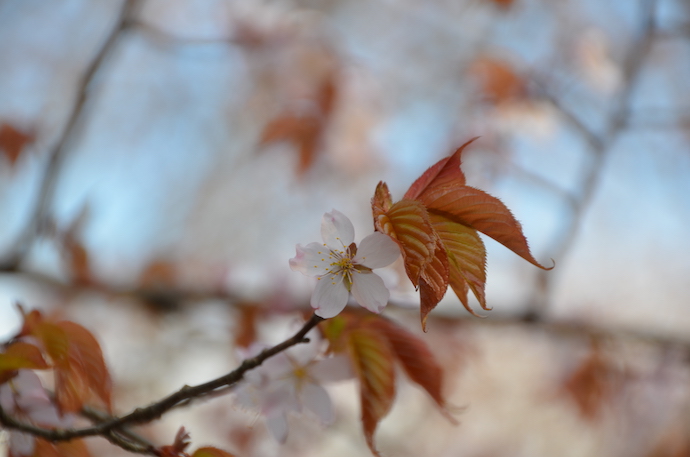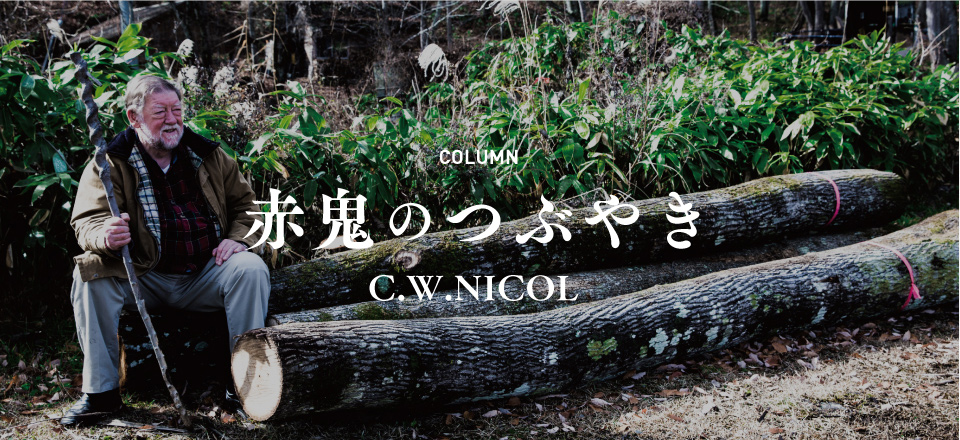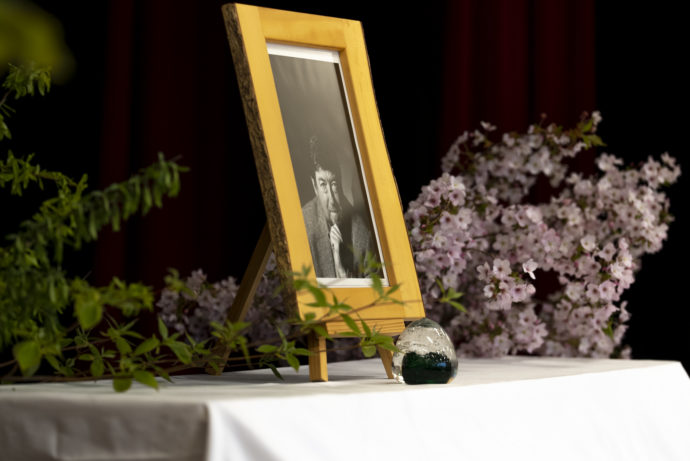Column
【赤鬼のつぶやき C.W.ニコル】ヤマザクラ(YAMAZAKURA)

黒姫に住まいを移してから植えたサクラは、すでに数百本になりました。アファンの森ではヤマザクラの木々が10メートルを越えるまでに育ち、落ち着いた色合いの太い幹も目を楽しませてくれます。日本には二百種類以上のサクラが生育していていずれも劣らぬ美しさですが、山に咲く野生の「ヤマザクラ」は特別です。
ヤマザクラの葉はやわらかく、緑色の葉が素朴な花と同時に芽吹きます。そのため、都市で目にするサクラよりも繊細でおだやかな印象を与えます。花が散るところを眺める人だかりはないし、武士の切腹や、若くして儚く命を失う若者を英雄にまつりあげる詩や文学になることもありません。
そしてヤマザクラには実がならない、と言われるのを聞いたこともありますが(日本に数年暮らした経験のある外国人は、この国について知ったかぶりをしたがることがあります)そんなことはありません。ちゃんと果肉の中にちいさな種が入っている、ちいさなサクランボをつけます。鳥たちも、クマも、そしてオールド・ニック(私)も、この甘酸っぱい実が大好きです。

大きめの瓶にこのヤマザクラの実を入れ、沖縄の黒糖と泡盛を注いで一年ほど浸けておくとすばらしい果実酒ができあがります。痛風にも効果があります。よく冷やした炭酸水で割れば、最高のサマーカクテルのできあがりです。
薫製をつくるときにもヤマザクラはかかせません。魚やソーセージ、ハムやチーズ。昔は炭にもよく用いられていました。
赤茶色の固いヤマザクラ材は、特にヨーロッパとアメリカで高い評価を受けています。化粧板として表面の仕上げに使ったり、家具、戸棚、楽器の材料にも適しています。きめが細かいので、お椀などのろくろ細工に供することもできます。

わたしの知る限り日本にしかないものだと思いますが、「樺細工」という工芸品があります。これは、正確には「カバ」ではなくヤマザクラから作られます。ヤマザクラの皮をスギなどの芯に巻いてつくった容れ物は、軽くて丈夫、かつとても美しい茶筒や薬入れになります。ヤマザクラならではのきれいな模様と色合いは、刀や鉈の鞘としても重宝されています。
そしてこの南信州に産まれた人物に、俳人の小林一茶がいます。一茶は、山桜を詠んだ句をたくさん遺しました。
山桜人をば鬼と思うべし
わたしの盟友で師でもある建築家の池田武邦さんが、こんな話をしてくださったことがあります。池田さんは戦中、戦艦大和に同行する巡洋艦「矢矧」に乗っていました。敗戦を覚悟して沖縄に向かう船の上で、彼と帝国海軍の乗組員や軍人たちはみな九州を振り返り、緑色の山並みをずっと見つめていたそうです。深い緑色がゆるやかに描く曲線に、奥ゆかしい彩りを添えながらまるで彼らを励ますように咲いていたのがヤマザクラだったといいます。少なからぬ乗組員にとって、これが最後に見るふるさとの姿になりました。その日から、野生の力強さでなにものにも縛られないヤマザクラの木が、いつでも池田先生の心の中にあるのだといいます。そしてわたしにも、そのヤマザクラがはっきりと見えるように思います。

2016年7月30日
C.W.ニコル
写真提供:C.W.ニコル・アファンの森財団
Ever since I moved into my own house here in Kurohime, Nagano, I have planted hundreds of cherry trees. Most of them have been Yamazakura, planted in what is now our Afan Woodland Trust, and many of them have now grown to be ten metres or so in height, with thick, dark trunks. Although there are supposedly well over two hundred cultivars of cherry trees in Japan, all of them beautiful, I have always preferred the wild mountain cherry, ‘yamazakura’.
Yamazakura leaves, so delicate and green, develop at the same time as the simple blossoms, which make the tree seem more delicate and less intense than the cherry blossoms of the cities, and nobody makes a great fuss when the petals fall, no heroic poems of fallen samurai, or young life cut short in its prime.
I have heard people, (especially some foreigners who have lived in Japan for a few years and therefore presume to know everything), that wild mountain cherries do not have fruits. That is nonsense. Yamazakura have small, black drupes (fleshy fruit with a hard inner ‘pip’ or seed) that are bittersweet to the taste and greatly loved by birds and bears … and indeed, by Old Nic.
I like to put yamazakura cherries in a big jar, with a handful of Okinawan black sugar, topped up with 35% alcohol awamori; leave for a year and you have a fantastic cordial that is supposed to cure gout, and is a marvelous summer cocktail with iced soda water.
Wild cherry wood is hard, reddish brown in colour, and greatly valued (especially in Europe and America) for making veneers, and the wood is also used for furniture, cabinets, and musical instruments. It is a fine wood for woodturning, making bowls and so forth.
Wild cherry wood is also greatly valued for smoking fish, sausages, and ham, even cheese. In the past it was also widely used for making charcoal.
Perhaps unique to Japan is the artistic craft of ‘kaba zaiku’, which is misnamed as far as I am concerned because the material comes from wild cherry bark, not birch. Wild cherry bark is airtight, and has long been used, often molded onto other woods such as cedar (sugi) to make light, strong, beautiful containers for tea, medicines and such. Kaba zaiku, with its beautiful patterns and deep colours, is also favoured for fine sheaths for swords and natta.
Yamazakura was so much used in the Nagano countryside that Kobayashi Issa (a native of these parts) wrote that:
Wild mountain cherries,
They must thinks that all men are devils.’
My dear old friend and mentor, the famous architect Ikeda Takekuni, when sailing aboard the cruiser Yahagi, which accompanied battleship Yamato on her suicide mission to Okinawa, told me that he and many other Imperial Navy sailors and officers looked back at the green hills of Kyushu. For all too many this was the last sight they had of their native land, those deep green slopes, gently dabbed with the delicate colours of blossoming, life-affirming yamazakura. To this day, Ikeda-sensei has a special place in his heart for wild, free yamazakura, and so do I.
C.W.Nicol
Kurohime
July 30th. 2016
C.W.ニコル
作家・1940年イギリス南ウェールズ生まれ。1995年日本国籍取得。カナダ水産調査局北極生物研究所の技官・環境局の環境問題緊急対策官やエチオピアのシミエン山岳国立公園の公園長など世界各地で環境保護活動を行い、1980年から長野県在住。1984年から荒れ果てた里山を購入し「アファンの森」と名づけ、森の再生活動を始める。2005年、その活動が認められエリザベス女王から名誉大英勲章を賜る。2011年、2016年に天皇、皇后両陛下がアファンの森をご視察された。





